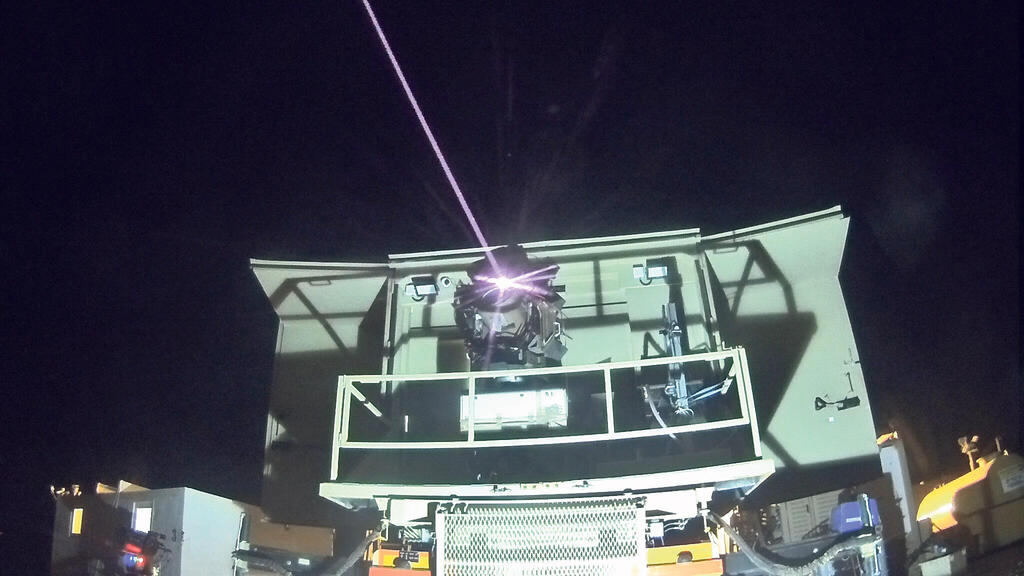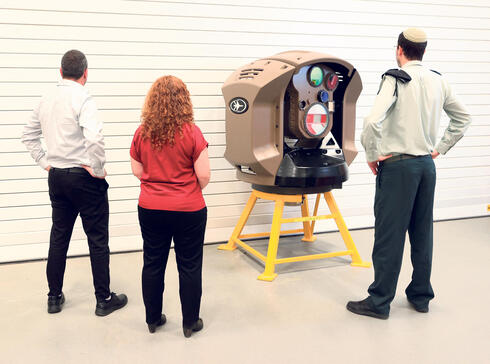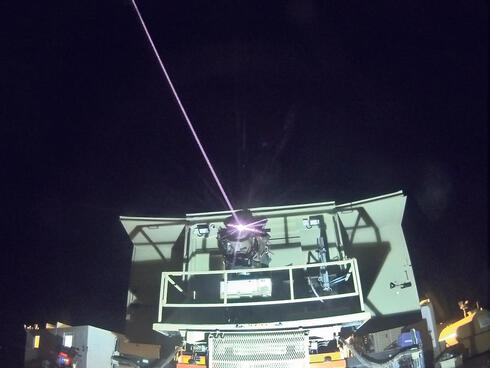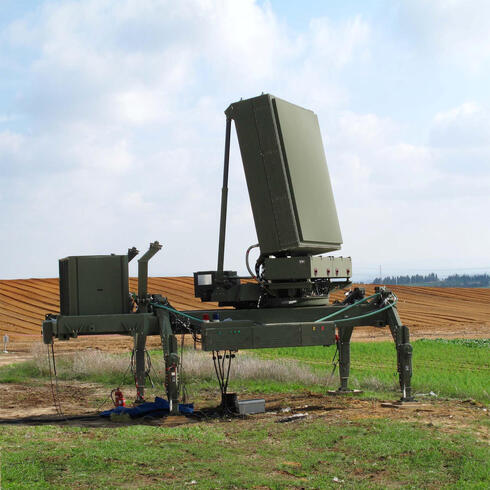
Beam me up: Israel’s new laser system is a security game changer
"Magen Or" (Iron Beam) is the next step up in Israel's self-defense: a laser system that can "cook" rockets, missiles or drones from afar, and at zero cost compared to the Iron Dome. It will be able to intercept rockets from Gaza even before they cross the border while Israeli citizens sleep soundly with no need to sound alarms
Did Israel test its new laser system Iron Beam to intercept Hamas missiles?
The dream of a new security system that intercepts rockets using a powerful laser, an optical shield, is one that Israel’s citizens can still only fantasize about. However, the development of such a system is accelerating these days in preparation for its deployment in southern Israel. "I want us to reach a situation that will cause the enemy to completely despair. Let them understand that we have laser pointers deployed where necessary, that the enemy can shoot what they want at us but everything will be intercepted almost at the moment of the launch itself, long before it reaches Israeli territory and threatens someone or something here. In this situation, we may not even have to activate the alarms in Israel. Why would a family from Sderot have to wake up in the middle of the night to run to their bomb shelter if we already intercepted the threats long before they crossed the border? It will be quiet. For us, this is a complete negation of the enemy's capabilities."
This futuristic scenario comes from Major Hananel, one of the leaders of the Magen Or (Iron Beam) program under development by Rafael and the Ministry of Defense which is expected to be ready for operational use by the IDF next year.
More than a hundred engineers from Rafael's Research, Development and Engineering division are currently working on the development of the Iron Beam that will allow the interception of threats such as mortar bombs, rockets, anti-tank missiles, drones, and various other objects, with the precision of a laser, at the speed of light - and at a minimal cost compared to those of the Iron Dome. "We are currently at a peak stage in the full development of the system," says its chief engineer, Dr. Yochai, who has been working on its development for 17 years. After a long and complicated pregnancy, his “baby” is beginning to take shape.
But Yochai, who has experienced ups and downs in this ambitious plan, is still far from the place where he can afford to rest on his laurels.
A new security age
Rafael and the Administration for the Development of Weapons and Technological Infrastructure in the Ministry of Defense invited Calcalist for a rare first glimpse into the guts of the new defense system that is about to redefine the battlefield. For about two decades, the defense industries have been trying to get their hands on effective technologies that would allow the interception of rockets through lasers, and a sequence of advances and breakthroughs that have occurred in the last five years is going to make this possible.
If there are no dramatic and unexpected last minute disruptions, it is possible that in about a year an innovative weapons system will be deployed in the field that may earn a place of honor alongside the tank, the fighter plane, the rifle and the missile.
At least in the first stages of its life, Magen Or will operate alongside the Iron Dome, which recently marked 12 years since its first operational interception. The division of labor will be clear. Iron Dome will detect a launch towards Israel, the system's mission computer will analyze in milliseconds the rocket's flight patterns, calculate trajectory, angles, speed and altitude, and after reaching a conclusion about its estimated falling place, decide whether to intercept it or allow it to fall in an open, unpopulated area. Should interception be required, a powerful energy strike from the Iron Beam can do to a rogue rocket what an expensive interceptor missile has done until now.
The price of a "Tamir" interceptor missile launched by Iron Dome is about $50,000 and sometimes two of these are launched at one rocket that threatens to hit a populated area to ensure its destruction. On the other hand, the price of interception using a laser beam depends mainly on the electricity tariff and, in any case, is negligible. According to Maj. Hananel, "the initial benefit of Magen Or is in the dramatic improvement in our position in the economic war and in the management of the 'interception economy'. A laser is simply light, and it is nothing compared to an advanced interceptor missile that costs tens of thousands of dollars. The enemy also knows that we have The Iron Dome. They know its high interception rates and continue to launch rockets and mortars at Israel because they understand it still causes us to rush us to shelters, disrupts our daily routine and occasionally also hits. The enemy understands that for every such cheap and simple rocket they fire, we launch a super advanced interceptor missile that costs a fortune. The enemy is waging an economic war with us and Magen Or will stop it."
Treatment of symptoms
It has been said before, after the first operational deployment of the Iron Dome 12 years ago, and it is proper to say again now, with the expected entry into the battlefield of a new and groundbreaking system: Israel protects itself knowingly at the expense of stable permanent solutions that can be achieved through political arrangements or through clear and unequivocal military decisions. Meanwhile, instead of curing the infection, Israel continues to flood itself with painkillers.
Hananel, who understands this problem very well, says that at least at the beginning this attitude bothered him too: "I remember the start of the project and yes, I had a difficult moment because I was looking at the long term in the face of the fact that we defend ourselves knowingly and fortify ourselves from all directions. So we have the Arrow missiles and we have the Iron Dome and we have other things that intercept and protect, but in their name we also allow ourselves not to attack or solve our problems in the area. So at least Magen Or reduces the economic burden. I assume that a cheap treatment of threats that are targeted using a high-powered laser will allow many resources to be diverted to other needs in the security system or outside of it. Wars are an expensive thing and after each round of combat someone writes a check and someone else pays it. We introduce a very important variable into this equation that will save a lot of money."
The form of interception using a laser will also be significantly different from the form of interception to which we have become accustomed in the dozen years of the Iron Dome, which brought out the masses to witness dramatic shows of spectacular explosions, white trails and smoke mushrooms in the skies over Israel.
Action fans will be disappointed to learn that the beam that will erupt from Magen Or will not be visible to the naked eye, during the day or at night. The process itself should be silent, because the firing of the beam at the target is not accompanied by the thunder of a missile leaving the launcher, similar to an interception using the Iron Dome system.
Instead of an explosion, the beam directed from Iron Beam at the target rocket will kill it through rapid “cooking” at a very high temperature. The power of the beam is about 100 kilowatts and its diameter is about that of a 10 shekel coin. At the moment, its effective range is estimated at about 10 kilometers, but this is not a final number: "The only thing that makes noise with Magen Or is the huge generator that provides it with the energy it needs to produce the laser beams that it will launch at the targets we intended for it," Yochai says.
The developers of the system do not say at this stage how long the operation of the laser itself lasts - which is the length of time the laser beam is placed on the intercepted object and “cooks” it at high heat until it is neutralized. And even then, there is no need for an explosion to be heard, because the laser can be placed on one of the rocket's wings, melt it, throw it off balance and send it spinning to the ground or break it in the air.
Another question to which the development teams refuse to provide an answer concerns the rate of interceptions that the laser beam is capable of delivering within a certain period of time. The answer will most likely be provided by the reality on the ground, and in any case, Rafael says that Magen Or is expected to be another layer in the multi-layered defense system that will operate in a hybrid manner. The ability to direct the system towards different targets in conditions of stormy weather, fog, sandstorms and clouds will range from limited to impossible - which will require in any case to keep the Iron Dome on full alert, as well as its interceptors.
Intercepting objects with a laser is an old fantasy. Israel started looking at this prospect three decades ago and it was not alone. The Americans even developed a system that claimed to be such, called Nautilus, based on a chemical laser, and even demonstrated to the heads of Israel's security system its interception capabilities. In those days, Israel was looking for solutions to the problem of the Katyushas being launched from Lebanon towards Kiryat Shmona and the north of Israel, and the IDF thought of placing the enormous Nautilus in the Manara area so that it would drop Hezbollah's Katyushas like flies. This hope was premature and ended in disappointment.
"A chemical laser has only disadvantages," Dr. Yochai said, explaining the main reason that the Nautilus program became a white elephant and ended up in a scrap heap in the backyard of its manufacturer Northrop Grumman. "It emits toxins into the environment and atmosphere, it is flammable and requires regular care and maintenance. It is tough, it is bad in terms of its transport and mobility on the battlefield, it is limited in the amount of its interceptions, and each loading of the system for additional interceptions costs a lot of money."
The shattering of the Nautilus dream along with the rise of the rocket threat from Gaza kept Rafael's engineers at the drawing board until the Iron Dome was developed. While it is intercepting and thwarting, albeit at a high cost, a variety of threats within Israel's borders, it has provided the defense industries the time needed to dedicate themselves to the difficult development challenges of an interception system based on an electric laser.
The team behind the system
Yochai has waited for more than a decade for this moment when all the stars began to align. He is 37 years old, born and raised near Machon David, which is one of Raphael's main sites of activity in the north of Israel. His parents are confined to wheelchairs due to polio. Both have doctorates, his mother is a doctor of biology and holds a senior public position in one of the local authorities in the north, and his father is a doctor of physics, a Rafael retiree who still continues to work for the company in the field of electro-optics. Yochai, who came to Rafael straight from his service in the IDF, specialized in the field of lasers and completed his doctorate in materials engineering at the age of 29.
The engineer of the laser pointer, Tanya, age 39, has also been working on the laser system since the first day she was hired at Rafael, about 13 years ago. She is a married mother of three and lives in the north.
Related articles:
Hananel, the project officer accompanying Magen Or on behalf of the Ministry of Defense, is 42, married and the father of two and lives in Jerusalem. He is a member of a privileged family in regards to high-profile security development programs. One of his brothers retired from the IDF with the rank of lieutenant colonel after performing a variety of key positions, a second brother served as the chief scientist of the IDF's ground forces and a third brother served as a head of department at the Israel Missile Defense Organization of the Ministry of Defense, the department that leads the advanced defense missile program Arrow 3, and today is a senior member of the Shin Bet. "More than once in the past we found ourselves sitting behind the same discussion tables in the Ministry of Defense, each with his own assignment and project," says Hananel.
Around the table in the discussion room at Rafael's facility in the north, they talk about the scenarios that will one day concern Magen Or. There it is assumed that, like Iron Dome and other systems, it will not be long before it is required for initial operational interceptions, because that’s how it is in Israel, which is considered the world's largest testing ground for weapons systems.
The long list of scenarios to which Magen Or is intended also includes insights that emerge from the war in Ukraine. Some of them are also related to the Iranian Shahed-136 UCAVs that are used by Putin's army and wreak havoc throughout the country. "We look a lot at what has been happening in Ukraine in the last year and I prefer not to go into too much detail on this issue," Yochai says. "The fact that there are 250,000 rockets, missiles and UCAVs that are aimed at Israel from almost every possible direction also pushes us to tell the story of our capabilities. This is part of the drive, we have to strive for good solutions to complex problems. Show me another country that is dealing with a situation where its citizens are being attacked every day with rockets and mortar bombs like Israel."
The understanding of the threats and their severity make them tangible and provide for the teams led by Tanya, Yochai and Major Hananel a motive that spurs them on to constantly look for the breakthrough that will bring about the change. "One day people will turn on the radio and hear a report of a first operational interception through a laser beam and it will happen thanks to these people, and hundreds of other employees who give their all to the success of this system and to bring security to Israel," says Dr. Ran Gozali, head of the land and sea division at Rafael, who leads the Magen Or program on behalf of the company.
In the near future, the work of assembling Magen Or's first battery will begin, and Tanya is ready: "We must be as precise as possible. This battery should realize all the goals we aimed for at this stage and it should deliver the goods in field and combat conditions for at least 15 years. Here there are many, many disciplines of mechanics, electronics, and optics. There are many decisions that need to be made and quite a few components that affect other components. There is always something that comes at the expense of something else. There will always be the small change that will ultimately affect four disciplines in ten other places and at this stage the eyes should be on the full picture because there are a lot of things that can go wrong," she says.
A few weeks ago, the protest against the government’s proposed judicial reform reached the gates of Machon David, where Rafael pensioners together with former senior officials in the defense industries called on the government to withdraw its legislation: "This debate does not penetrate the walls behind which Magen Or's teams work," says Hananel. “When it comes to such a significant goal that seeks to save human lives, we do not bring any political discourse into the project."
* * *
"Fulfilling a dream"
Elbit's airborne laser can also intercept hypersonic missiles
Alongside Rafael's impressive achievements, Elbit Systems recorded a significant milestone in regards to lasers when it was able to intercept a number of unmanned aerial vehicles using a laser beam that was fired at them from a plane flying a kilometer away. According to Elbit, all the piloted vehicles targeted by the laser were destroyed: "No one has done this before," says Elbit CTO, Oded Ben David. "This successful experiment gave us a lot of self-confidence regarding the plan to create in just a few years from now an aerial laser interceptor. For me, this is the fulfillment of a childhood dream, to produce combat systems that will work through a laser. We need this for the security of the country and we want it to be mature and operational because we need it not tomorrow, but yesterday."
Elbit's vision speaks of a powerful laser that could be carried in fighter planes that would intercept enemy fighter planes or drones at the speed of light, as well as missiles and even hypersonic missiles, which in recent years constitute a growing threat due to being eight times faster than the speed of sound, and therefore cannot be intercepted by the existing air defense systems.
The first use of hypersonic missiles was made more than a year ago by Russia in its war in Ukraine when it attacked weapons depots in the country using Kinzhal missiles.
Elbit Systems has been operating in the field of aerial lasers for many years and, in fact, already has a product that is based on a laser, although at a lower intensity than is required for interception purposes. In 2002, shoulder-fired missiles were fired at an Israeli Arkia plane that took off for Israel from the Mombasa airport in Kenya, but missed.
The attempted attack led Elbit to develop the defense system for passenger planes called "Magen Rakia". This is a system that is installed in the body of the plane and as soon as it detects a missile approaching it, it deflects it from the impact path through a laser beam that it fires.
Since then, Elbit has already adapted the defense system to other aircraft such as combat helicopters and even to private planes used by businessmen who fly around the world and heads of state as well. Such a system was also installed in the "Knaf Tzion" (Wing of Zion) plane built by Israel Aerospace Industries for the Prime Minister and the President of Israel.
The defense industries believe that the breakthroughs in the field of lasers will expand their product baskets in the coming years and allow them to integrate laser capabilities to protect tanks and APCs against anti-tank missiles. Rafael is already working on such adjustments.
In addition, it is possible that on the basis of capabilities achieved in the field, it will be possible to develop a variety of offensive systems based on lasers, with an emphasis on the precision they could provide to ensure precise damage to targets even in an urban environment. "It is better that we first protect ourselves with the laser, because there are too many threats directed at us. After that, the sky's the limit. It will be possible to do many more things with the laser," says Ben David.



